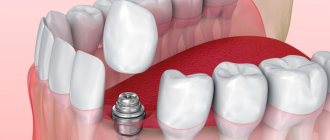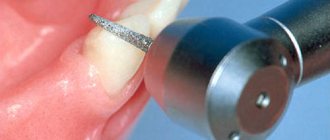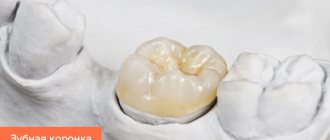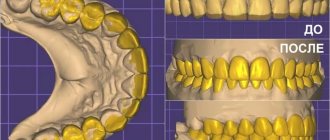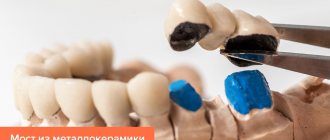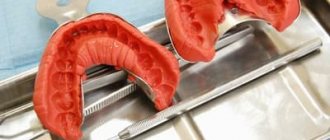Description of the procedure
Tooth preparation is the removal of hard tissues that are damaged or interfere with the fixation of the crown.
Previously, turning under metal ceramics was long and painful. However, thanks to modern anesthesia drugs and the latest instruments, the duration and pain are significantly reduced.
During the procedure, the doctor strives to preserve healthy organs as much as possible. In this case, it is necessary to create natural forms, which is achieved through the formation of ledges.
For proper preparation, the following criteria must be met:
- the dental organ has retained its natural shape;
- the tooth stump is reduced and slightly tilted;
- the tooth is reduced in size by up to 2 mm;
- There are no unpleasant consequences near the dental organ.
Thanks to the preparation of teeth, the metal-ceramic crown receives the place it needs, so that it does not exceed the neighboring teeth in height and does not protrude outward or inward.
The crown should fit tightly under the gum, which is facilitated by a ledge under the gum.
To install a solid crown, up to 0.3 millimeters must be removed from the lateral surface without damaging adjacent teeth. To install a metal-ceramic prosthesis, the tooth is depulped and then 2 millimeters are removed from it. There should be a ledge on each side.
The doctor determines what size layer to remove based on the size of the tooth and the characteristics of its position in the dentition.
Basics of tooth preparation for metal-ceramics
Dental preparation is both a medical procedure and a technological process. This procedure allows for effective treatment of dental tissues against caries. And the technologies used make it possible to reliably fix fillings and dentures and thereby preserve the tooth.
Tooth preparation provides effective treatment
The entire procedure can take place not at once, but in several stages. In this case, the decision is made by the dentist. The procedure is carried out using a diamond instrument.
- The procedure begins with grinding the sides of the tooth so as not to damage the adjacent ones.
- The enamel of the required thickness is removed evenly from all sides. Recesses are left at the base of the tooth under the gum, at the level of the gum, or above the gum.
Enamel of the required thickness is removed evenly from all sides
- The final result largely depends on the condition of the pulp - the connective soft tissue located inside the tooth. To avoid damaging it, dentin (the hard part of the tooth) is left at least 1 mm thick, and during grinding it is constantly cooled with water.
- The bur speed decreases with increasing thickness of the removed enamel. The grinding depth is controlled using various devices and the application of deep grooves for orientation.
- The wall of the stump (the remainder of the tooth after grinding) is left rough to better secure the crown. The shape of the crown should be as identical as possible to the shape of the stump, so that there are no gaps between them through which bacteria can penetrate.
The stump is left rough so that the crown is better secured.
- During the turning process, a circular shoulder is formed. Its shape and width are determined individually for each case. The width of the ledge is equal to the thickness of the crown wall. It is formed not strictly vertically, but at an angle and with curves around the perimeter. The optimal tilt angle is 120 degrees. Rounded corners are necessary to increase the precision of crown production. They also help reduce the tension between the crown frame and the cementing material that secures the crown. The tooth preparation procedure may not involve creating a ledge. In this case, the edges of the denture do not have additional space for themselves and put pressure on the gums. There is another negative effect: plaque accumulates at the junction of the crown and gums and destroys the tooth. Therefore, this preparation option is used infrequently.
ledge
Peculiarities
Grinding teeth for metal ceramics has the following features:
- The need to remove a significant layer of enamel and dentin (up to 2 millimeters).
- The use of anesthesia so that the patient does not feel pain during grinding. The most common methods are infiltration and conduction anesthesia.
- The main goal of specialists is to preserve as much bone tissue as possible and remove all damaged areas.
- After removing the tissue, a truncated cone is obtained, the edges of which are then slightly rounded.
- Grinding should be done intermittently after every 2-3 seconds.
- The tool must be constantly cooled during grinding so as not to cause a burn to the pulp.
- The contact surfaces must be ground with the device at low speeds.
Types of ledges during turning
The presence of shoulders guarantees the most accurate and reliable fit of the crown. Also in this case, the prosthesis will not damage or rub soft tissues.
The photo of the prepared teeth clearly shows different types of protrusions and it is clear what they are. They form right at the base, where the crown touches the gum, and a special thread is used to push it back.
Types of protrusions:
- Round, its thickness is no more than 1.2 mm. Considered a classic in metal-ceramic dentures.
- Knife-shaped (3-4mm). It is often used by dentists, especially for hard structures. More suitable for oblique teeth.
- Shoulder (2 mm). Maximum grinding of dentin and removal of pulp is required. However, as a result, the prosthesis is held more firmly, and the crown itself looks natural and aesthetically pleasing.
Stages of the procedure
Let's take a step-by-step look at how teeth are ground for a metal-ceramic crown:
- Creating grooves. The doctor makes peculiar incisions that will show how much hard tissue needs to be removed. These grooves subsequently contribute to uniform grinding. Creation of notches can be done with a bur or a shaped head in the form of a wheel. They are carried out from the vestibular side to a depth of 1.5 millimeters. The ledges on the palatal and vestibular sides are removed.
- Removing tissue from the vestibular and oral sides. Maximum caution is important at this stage. Diamond burs directed parallel to the tooth remove the required layer. When working on the palatal side, the palatal tubercle is preserved.
- Preparation from the occlusal surface. This stage consists of preparing one and a half to two millimeters, while not disturbing the anatomy of the chewing surface. The living crown of the anterior dental units is thus shortened by 25%.
- Separation of the contact side. It is important to separate the medial surface from the distal one and then remove the tissue. A diamond bur with flame-shaped or needle heads is used. 0.5 millimeters are left above the gum. To prevent periodontal injury, a dental matrix and an interdental wedge are used.
- Gum retraction. If it is necessary to immerse the bur deeply, you need to protect the gums. Therefore, it is moved away with the help of special threads, rubber rings and a spatula. This stage is important for taking an impression so that a high-quality model can be easily made.
- Formation of the ledge. The width of the ledge can be 0.5-1.5 millimeters, depending on the anatomy of the dental organ. It is made with a face bur.
- The final stage of processing. The dental stump should be in the form of a uniform cone. At this stage, irregularities are cut off, protruding edges are removed, and the stump is rounded.
Is teeth grinding always necessary?
If a metal-ceramic crown is placed on an existing tooth, rotation is required. Guarantees a secure fit of the crown, a long service life and the absence of side effects and complications.
Clinical indications for tooth preparation:
- The shape of human teeth is imperfect by nature. It is difficult to make a prosthesis for an incorrect tooth, and ensuring its fit is almost impossible. In this case, there should be no free space between the material and the dentin, into which air, food and bacteria can enter. Grinding gives the tooth a uniform shape, allowing the crown to be firmly secured.
- Pre-alignment makes the work of the dentist and dental technician easier. The prosthesis is easily and securely attached to the prepared abutment of the correct shape.
- Grinding reduces tooth size. The metal-ceramic prosthesis already has a certain thickness. To prevent it from coming out of the dentition, the tooth under the crown should be smaller.
Laser processing
Thanks to laser pulses, a thermal effect occurs on the fluids contained in the teeth. In this case, the structure of the material is microscopically destroyed. Unnecessary tissue is then cooled with an aqueous solution or air, and then removed without hindrance.
Laser preparation has the following advantages:
- no noise when the tool operates;
- safety of the procedure due to the absence of tips in the device that rotate at high speed;
- the frame for the future crown is obtained quickly and without pain;
- infection during the procedure is excluded, since the instrument does not touch the tissues.
Tunnel preparation
Tunnel turning is carried out using turbine units with diamond or metal tips. At the same time, it is important that the equipment is new, since a worn-out instrument can cause overheating of the tissues and their destruction.
Note: With this method, it is possible to save as much material as possible for future crown installation. The result of removal can be predicted in advance, and during the procedure it is easy to control the volume of the removed layer.
This type of preparation is used today more often than other methods.
Preparation with abrasives
An alternative to a drill with its rotating drills is also the supply under pressure of air mixtures containing an abrasive powdery substance. By acting on the enamel, this mixture gradually removes hard tooth tissue.
Features of preparation with abrasives are as follows:
- speed of the procedure;
- absence of tissue overheating and painful sensations;
- gentle effect on the dental shell;
- careful grinding, which allows you to obtain the necessary stump while preserving a significant amount of healthy tissue.
Is dissection painful?
Removing hard tissue is a painful procedure. But with high-quality anesthesia, the patient does not feel pain at all. However, there are situations when, after the anesthesia wears off, the tooth or gums around it begin to hurt.
The main cause of pain in this case is the removal of a large amount of tissue from the vital dental organ. In this case, the tooth, the pulp of which is located under the remaining thin layer of hard tissue, hurts when touched, as well as when exposed to cold or sour food. In such a situation, it is better to consult a doctor so that he can install a temporary crown to protect the ground tooth or cement the thinned area.
Pain may also be a consequence of pushing back the gums with a special thread in order to see the working area when grinding. The floss puts pressure on the soft tissue between the tooth and gum, creating swelling and pain. This pain should go away within two days. If it occurs after a longer period of time, it is better to consult a doctor, as this may be a signal of nerve inflammation or the development of periodontitis.
Advantages of live tooth preparation
It is much easier for a doctor to dissect a living tooth than one in which the nerve is already dead.
- Depulped teeth are much weaker than living ones, which do not break or crumble over time.
- Living teeth are much more resistant to caries.
- No need to install pins.
- The procedure for depulping teeth is not cheap. Prosthetics of living teeth significantly reduces the financial costs of the patient.
- The dental nerve is preserved.
It is much better to prepare a living tooth than one with a dead nerve.
How is preparation done on a living tooth?
- Grinding of a living tooth must be carried out under anesthesia in a slow mode.
- A new bur and a special handpiece are used for each patient.
- To prevent the occurrence of an inflammatory process, a special coating is applied.
- After the grinding procedure, temporary crowns are immediately installed on the prepared teeth, which are fixed with special cement containing an antiseptic.
Temporary crowns are placed on the teeth after preparation.
Purpose of installing temporary crowns
After grinding down the tooth, a temporary crown made of plastic is placed on it, which will remain in the oral cavity for two or three weeks while the permanent prosthesis is made.
For some patients, the fact that a doctor makes and places a temporary crown is incomprehensible and even seems meaningless.
But this procedure is simply necessary. Since temporary crowns protect teeth from external influences, and also correctly distribute the load when chewing.
The advantages of using temporary crowns are as follows:
- Teeth ground for a crown are not protected from the harmful effects of pathogenic bacteria, which can cause inflammation of the teeth under a permanent crown, and temporary products protect them from infection.
- When biting, a ground tooth can be displaced by the opposite dental organ, which can lead to unwanted errors during prosthetics.
- Temporary dentures give the oral cavity an aesthetic appearance, and with it the patient’s self-confidence. They operate in the same way as permanent ones, only they are made from budget material.
Choosing crowns: metal, ceramic or metal-ceramic?
Dental prosthetics are carried out using various materials. Each has its pros and cons.
Metal crowns are very durable and relatively cheap. The disadvantage is that they are not very aesthetically pleasing – they are noticeable against the background of natural teeth. Therefore, they are used mainly for prosthetics of posterior teeth.
Metal-ceramic crowns are the best choice because they combine aesthetics and durability
Ceramic crowns, on the contrary, are expensive, not as durable as metal ones, but have high aesthetic values. They are used for prosthetics of front teeth, which are in the visible zone and do not experience significant chewing loads.
Interesting! To increase the strength of ceramics, it is combined with metal. Such compositions have a reasonable price, increased strength and are almost indistinguishable from natural teeth.
